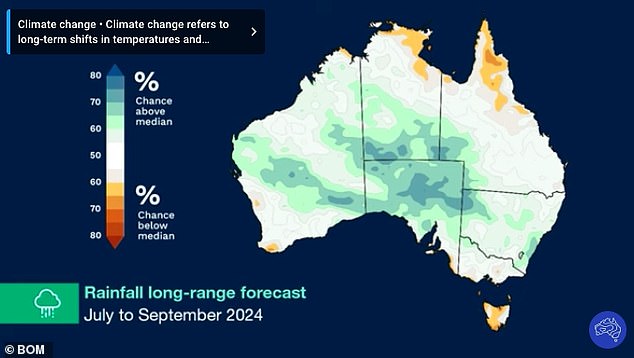Sydney, Melbourne, Brisbane weather: Rain warning issued
Heavy rain expected across much of the country this week could herald the start of a wetter than average winter and spring for most Australians.
A giant rain band stretching nearly 5,000km across the country will inundate all areas south of Geraldton in Western Australia and Brisbane in Queensland.
Large pastoral areas in western Western Australia, South Australia and the Murray-Darling Basin, which covers more than a million square kilometres in southeastern Australia, will see up to 25mm of rainfall this week before the rain band shifts east.
Up to 50mm of rain could fall in outback areas of eastern Australia, including northern New South Wales and southern Queensland, on Sunday and Monday.
The amount of rain falling in the area is expected to be greater than the average rainfall for the entire winter.
Meanwhile, a band of rain will continue to move across Western Australia on Tuesday and Wednesday, bringing strong winds, showers and cold temperatures.
Up to 50mm of rain is expected over a distance of 400km between Perth and Wapole.
The rainband then moves into southeastern Australia, where widespread rainfall of up to 30mm will flood southwestern Victoria and southern South Australia.
The heavy rains set to flood large parts of the country this week could herald the start of a wetter than average winter and spring for most Australians (people in Adelaide pictured)
This comes after a long-term forecast from the Bureau of Meteorology indicated that above-average rainfall was likely across large parts of eastern and central Australia from July to September, including pastoral areas in southern Australia and parts of the east coast.
The forecast also indicates that rainfall is likely to be within normal seasonal limits for most of northern Australia, Western Australia and Victoria.
“Parts of South Australia are still experiencing frequent storms at this time of year, creating a risk of flooding if there is heavy rainfall, particularly in areas where the ground is already saturated,” said climatology specialist Caitlin Minney.
In July, the chance of rainfall is lower than average in western Tasmania and remote parts of the far south-east of the mainland.
In the north, east and south of Australia, the days are likely to be warmer than average. Across Australia, the nights are likely to be warmer than average.

From July to September there is a chance of above average rainfall in eastern and central Australia
“While cold fronts and other weather events could still bring cool conditions, the long-range forecast continues to point to an increased likelihood of unusually high temperatures from July through September,” Minney said.
‘There is a greater chance of above-average temperatures throughout the country.’
This week a trough and cold front will bring icy winds and showers to the southwestern coast of Western Australia, all the way to the Pilbara.
The system is expected to cross the border on Tuesday, bringing cool temperatures this week.
In Sydney, a maximum of 10 mm of rain will fall on Tuesday. It will be over on Wednesday and the temperature will be a maximum of 19 degrees Celsius.
Thursday will be cloudy again and on Saturday there is a chance of showers.
Brisbane will experience wet and wild weather early in the week, with skies clearing on Wednesday and temperatures rising to a maximum of 25 degrees Celsius.

Northern Australia, Western Australia and Victoria will see heavy rainfall this spring
In Darwin, the skies remain clear and blue with a maximum temperature of 32°C this week.
Further south, the Australian Capital Territory will experience a cold and wet week, filled with showers, icy winds, frost patches and sub-zero temperatures.
In Hobart, more than 50mm of rain could fall in the west and east of the island state this week, while temperatures remain below 15 degrees.
Dry areas of southern South Australia will see some light showers early in the week, before a cold front and associated rain band bring between 10 and 30mm of rain to the same areas by the end of the week.
In Victoria, the same cold front will also bring showers to western parts of the state, with Melbourne expected to see the heaviest showers of the week on Tuesday.
